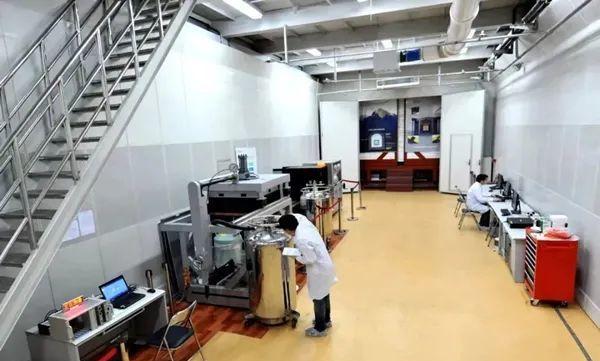【Sunburn our country heavy equipment 23】
This is a "very deep underground" with vertical rock covering a thickness of up to 2400 meters!
This is the "blackest" house in the world!
In this "black" house hidden deep in the middle of the Jinping Mountain Traffic Tunnel in Liangshan Yi Autonomous Prefecture, Sichuan Province, accompanied by a faint flash of atomic nucleus signal amplification, researchers stare at and capture next to the non-stop running instrument.
Here, is the China Jinping Underground Laboratory.
The job of researchers at every moment is to "find something". What are they looking for?

Look for the most "weak" light in the universe, dark matter, a substance that has not been "seen" but has an important place in the origin of matter and the evolution of the universe.
If the whole picture of the universe is compared to an ocean, so far, human beings have only explored a small part of this "ocean" due to limited means of understanding and observation. Numerous observations in astronomy show that dark matter accounts for about 85% of the mass of matter in the entire universe. However, it cannot be seen, touched, and hardly interacts with any object.
In order to capture this mysterious and "shy" dark matter, since the 21st century, more than 20 international detection experiments have been carried out. It is believed that whoever unveils it first will lead to another major leap in human understanding of the physical world and the universe.
At present, dark matter detection methods are roughly divided into three categories: "heaven", "into the ground" and "artificial dark matter": "heaven" refers to indirect detection experiments, in order to reduce the interference of the Earth's atmosphere, usually carried out in space; "into the ground" refers to direct detection experiments, in order to reduce the interference of cosmic rays, usually carried out in underground laboratories; "artificial dark matter" refers to accelerator experiments, that is, through the collision of ordinary particles to produce dark matter particles, mainly on the large hadron collider of the European Nuclear Center.
The research carried out by the Jinping Underground Laboratory in China belongs to the "entry into the ground".
Here, the 2,400-meter rock tunnel acts like a darkroom, firmly blocking out the noise of cosmic rays. Compared with other underground laboratories in the world, it has the deepest rock cover, the smallest cosmic ray flux, the largest usable space, and the advantages of convenient transportation, power and water.
On December 12, 2010, the "China Jinping Underground Laboratory" was unveiled and put into use, marking that China has a world-class clean low-radiation research platform. Subsequently, the Pangu Project (CDEX) high-purity germanium dark matter experiment led by Tsinghua University and the Panda Project (PandaX) liquid xenon dark matter experiment project led by Shanghai Jiao Tong University were settled.
"It's similar to 'waiting for dark matter to throw itself into a net.'" Yue Qian, a professor in the Department of Engineering Physics at Tsinghua University and the head of the CDEX dark matter experiment, introduced that in this extremely quiet laboratory, the target particles in the detectors placed by the two teams will "collide" with dark matter and get a little energy from them, and this energy can be turned into an ionization signal or a thermal vibration signal, or a flickering light signal. Scientists can record the various parameters after the interaction of dark matter particles and ordinary matter, count the laws from them, and then use these clues to piece together the information of dark matter little by little.
In fact, the probability of dark matter colliding with ordinary matter is extremely low. Scientists are not waiting for rabbits.
In the first phase of the 4,000-cubic-meter laboratory, the careful design of each experimental link and the every second of every scientific researcher are rushing towards two goals - efficiency, doing everything possible to improve the collision signal of dark matter; reducing costs, racking their brains to shield the interference signal of the background.
The results came one after another. In 2013, the CDEX collaboration published the results of the continent's first direct dark matter detection experiment. In 2014, the most sensitive international experimental results in the detection of high-purity germanium dark matter at the point electrode were given, which used the same detection technology to definitively exclude the dark matter presence area given by the CoGeNT experimental group in the United States. In the past two years, although the national major scientific and technological infrastructure of China's Jinping Underground Laboratory is still in the process of intensive construction, the two experimental groups have continued to make new breakthroughs, giving a series of international advanced achievements under different dark matter models such as annual dark matter modulation, dark photons, and axions, maintaining international "parallel running".
At present, the second phase of the experimental space under construction will increase to 300,000 cubic meters. More research teams are waiting to enter this expanded deep underground experimental space.
The Dark World, just for that one eye to "see"! On this road, the discovery after every bit of persistence will make mankind's understanding of the material world further, and it will surely engrave a stroke belonging to Chinese scientists in the history of science.
(Reporter Deng Hui)
Source: Guangming Daily (2022-04-12 01 edition)
Photo: China Jinping Underground Laboratory website
Editor-in-charge: Wang Yuanfang
Editor: Wu Yaqi